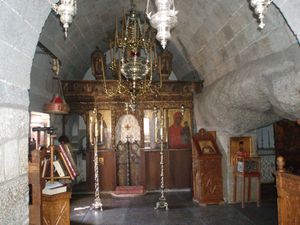Difference between revisions of "Patmos"
m (broke up some long sentences) |
(added Picture of the Cave of the Apocalypse) |
||
| Line 1: | Line 1: | ||
| + | [[Image:Patmos.JPG|thumb|right|Cave of the Apocalypse (Patmos)]] | ||
'''Patmos''' (Greek ''Πάτμος'') is a small Greek island in the Aegean Sea that was the place of exile of St. [[John the Theologian]] and from which he wrote the [[Book of Revelation]]. | '''Patmos''' (Greek ''Πάτμος'') is a small Greek island in the Aegean Sea that was the place of exile of St. [[John the Theologian]] and from which he wrote the [[Book of Revelation]]. | ||
| − | Patmos is the northernmost island of the Dodecanese Islands and is populated with [[church]]es and communities of Orthodox Christians. From the very earliest times, Orthodox Christian tradition has associated Patmos with St. John the Theologian. More specifically, it is remembered as the place where he recorded his vision from [[Jesus]] that came to us as the Book of Revelation. Revelation was written as an exhortation to the Christian believers to stay true to their faith during the persecutions near the end of the first century.<ref>P. N. Tarazi, ‘’The New Testament - Introduction, Vol. 3 - Johannine Writings’‘, St. Vladimir’s Seminary Press, Crestwood, New York, 2004 ISBN 0-88141-264-3</ref> | + | '''Patmos''' is the northernmost island of the Dodecanese Islands and is populated with [[church]]es and communities of Orthodox Christians. From the very earliest times, Orthodox Christian tradition has associated Patmos with St. [[John the Theologian]]. More specifically, it is remembered as the place where he recorded his vision from [[Jesus]] that came to us as the [[Book of Revelation]]. Revelation was written as an exhortation to the Christian believers to stay true to their faith during the persecutions near the end of the first century.<ref>P. N. Tarazi, ‘’The New Testament - Introduction, Vol. 3 - Johannine Writings’‘, St. Vladimir’s Seminary Press, Crestwood, New York, 2004 ISBN 0-88141-264-3</ref> |
The Monastery of St. John the Theologian, the Cave of the Apocalypse, and Chora, the island’s historic center, were declared World Heritage sites by UNESCO in 2006. | The Monastery of St. John the Theologian, the Cave of the Apocalypse, and Chora, the island’s historic center, were declared World Heritage sites by UNESCO in 2006. | ||
| Line 9: | Line 10: | ||
==External link== | ==External link== | ||
| − | *[[w:Patmos]] | + | *[[w:Patmos|Patmos]] |
| − | + | ---- | |
[[Category: Places]] | [[Category: Places]] | ||
Revision as of 23:46, April 16, 2008
Patmos (Greek Πάτμος) is a small Greek island in the Aegean Sea that was the place of exile of St. John the Theologian and from which he wrote the Book of Revelation.
Patmos is the northernmost island of the Dodecanese Islands and is populated with churches and communities of Orthodox Christians. From the very earliest times, Orthodox Christian tradition has associated Patmos with St. John the Theologian. More specifically, it is remembered as the place where he recorded his vision from Jesus that came to us as the Book of Revelation. Revelation was written as an exhortation to the Christian believers to stay true to their faith during the persecutions near the end of the first century.[1]
The Monastery of St. John the Theologian, the Cave of the Apocalypse, and Chora, the island’s historic center, were declared World Heritage sites by UNESCO in 2006.
Notes
- ↑ P. N. Tarazi, ‘’The New Testament - Introduction, Vol. 3 - Johannine Writings’‘, St. Vladimir’s Seminary Press, Crestwood, New York, 2004 ISBN 0-88141-264-3
